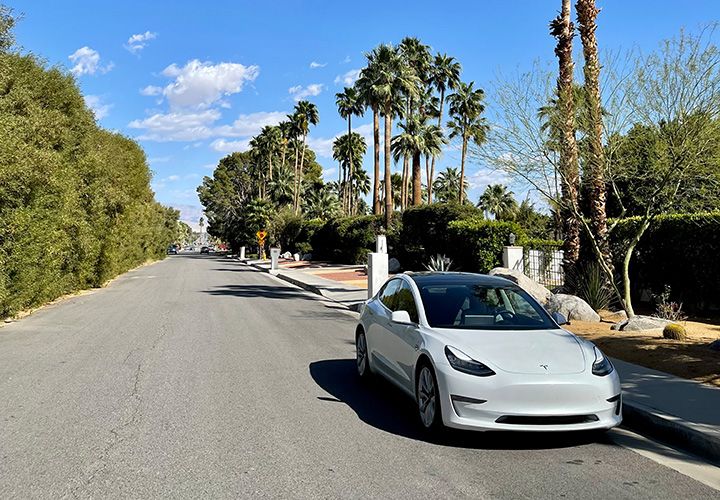(Bloomberg) —
Road trips are fun — especially when someone else handles the driving.
I just returned from a 12-day visit to the U.S. Much of that time, I was chauffeured by two longtime friends, Joe and Wes, around the American Southwest in their Tesla Model 3.
In my first battery-powered road trip, we drove from Arizona to Los Angeles. Then, after a brief respite following our return to Phoenix, we headed to the Grand Canyon and back. The ride was very smooth and the planned Supercharger stops proved to be fun intermissions rather than the nuisances I expected. I also got to experience Tesla technology that hasn’t made it to Europe yet: Full Self-Driving, or FSD, the controversial pay-to-unlock features that drivers have been beta testing on public roads.
We tried out FSD in downtown Phoenix. While the car self-parked fine and did well going straight, the driver-assistance system is still rough around the edges. It often brakes a bit too late and accelerates too abruptly for my tastes. When the car was about to make a left turn at a busy intersection, Wes quickly took over the wheel because it appeared the Tesla was about to veer into oncoming traffic.
Elon Musk says he’s confident Tesla can introduce FSD in Europe this summer, but I’m not so sure. The region is known to err on the safe side, and adapting the software so it can detect the different languages, traffic rules and road designs isn’t easy. Regulators are going to expect that developers of these systems have engineered them to be able to handle drivers taking trips, for example, from Denmark, down through Germany and the Czech Republic, and on to Hungary. That’s a lot of complexity.
Musk admitted last month Tesla still has “a lot of work” to do on special-case traffic situations before the carmaker will be ready to show FSD to European regulators. And even then, he expects them to be less permissive than their American counterparts.
“In the U.S., things are legal by default, and in Europe, they are illegal by default,” Musk said last month during the opening of Tesla’s factory near Berlin. “We have to get approval beforehand, whereas in the U.S., you can kind of do it on your own cognizance, more or less.”
Yeah, more or less. The U.S. National Highway Traffic Safety Administration has opened two defect investigations into Tesla’s standard Autopilot driver-assistance system. The agency opened the first probe after a dozen incidents in the last four years in which Teslas collided with first-responder vehicles. The moves suggest regulators in Washington may be losing patience with the carmaker. Any clampdown on Autopilot in the U.S. by what Musk has referred to as “the fun police” won’t help Tesla’s cause getting the green light for FSD in Europe.
Granted, European politicians are eager to ensure they don’t fall behind the U.S. and China when it comes to automated driving. German lawmakers agreed last year to allow some driverless vehicle trials on public roads. Mercedes-Benz late last year won regulatory approval to deploy a hands-free driving system in Germany, ahead of Tesla. Still, the system was approved only for use on stretches of the country’s Autobahn highway network at a speed of up to 60 kilometers (37 miles) per hour. That means it’s basically reserved for traffic jams and slow-moving traffic.
Autopilot has had a rough go in Europe. In 2019, Tesla pushed a software update to walk back some features because of a new driver-assistance system regulation. A Munich court ruled in 2020 that the company misled consumers about what Autopilot can do. German magazine Der Spiegel reported last month that a court in Darmstadt, Germany, had ordered Tesla to refund a Model 3 owner some 69,000 euros ($75,300) because the car’s automated-driving features didn’t work as advertised.
I’m all in favor of driver-assistance tech in cars — as long as it’s foolproof in what it’s designed to do, and buyers are made well aware its limitations and their duty to keep their eyes on the road. Tesla is far ahead of the pack when it comes to its in-car operating system, and some of its driver-assistance features work really well. Still, during our trip, I felt safest when one of my friends did the driving.
More stories like this are available on bloomberg.com
©2022 Bloomberg L.P.











